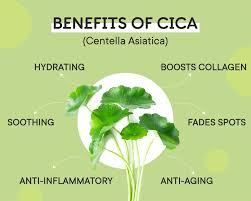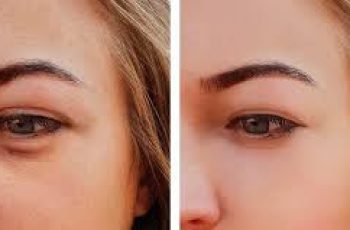
Skincare Benefits of Cica (Centella Asiatica)
Cica, centella asiatica, tiger grass, this herb goes by many names and has established itself as a highly desired ingredient in the skincare industry, particularly in K-beauty which we all know has an enormous following. So, what is it about this herb that makes it so popular?
What is Cica or Centella Asiatica?
Centella Asiatica, also called Cica is a botanical herb found growing in tropical, swampy areas throughout parts of Asia. Extracts of the herb have been used in natural Chinese medicine for thousands of years due to its skin healing properties. You may also find that products containing cica have the name “tiger grass” in the label, this comes from wild tigers being seen to roll amongst the plants to help treat any battle wounds they have and to rejuvenate their skin.
Well known for its healing, skin-soothing, antibacterial and inflammatory properties making it great for skin conditions such as eczema, psoriasis and scarring. It is also incredibly moisturising to help dry skin types!
With our busy and hectic lifestyle, our skin is usually prone to becoming quite imbalanced from lack of sleep and environmental aggressors. Cica has the ability to strengthen the skin’s barrier and improve the overall appearance giving you a clearer complexion. There is a huge list of benefits of cica and it has grown in popularity amongst skincare brands, making it a regular ingredient found in various products on the market such as moisturiser and even CC cream.
What are the skin benefits of cica or Centella Asiatica?
Anti- Ageing
Centella Asiatica is high in antioxidants that help to neutralise free radicals found in pollution and the sun’s UV rays. These free radicals cause damage to the skin’s barrier resulting in uneven skin tone and other concerns that are linked to skin ageing. Once the skin begins to age you will find that the loss of elasticity will cause the skin to droop and appear crepe-y. Cica is able to improve blood circulation and production of collagen resulting in the face looking more youthful and firm with reduced lines and wrinkles.
Soothing
Centella Asiatica contains asiaticosides which are incredibly soothing and healing for the skin. Sensitive and extremely dry skin types which suffer from redness, inflamed and sometimes itchy skin will see marked results in the comfort of their skin with visible signs of any irritation significantly reduced.
Moisturising
Not only is cica packed with antioxidants it is enriched with amino acids, fatty acids and beta carotene all of which provide huge amounts of nutrients for the skin making it hydrated and restoring the oil and water levels back to the skin’s barrier.
Healing
Cica can help with many skin conditions such as eczema, psoriasis, varicose veins and stretch marks. Centella contains “Madecassoside” which is a compound that boosts the antioxidant activity of the skin allowing any wounds or scars to become healed with an increase of blood circulation and strengthening the skin barrier. For those who suffer from blemish-prone skin, they will find that any breakouts, like spots, can be treated and cleared without any marks or scarring left behind.
Where can you find Cica?
Skincare – with the K-beauty popularity of this ingredient you will find it a vast selection of skincare products, such as serums, moisturiser and balms.
Topical- Cica can be applied topically on burns, scars, inflammation and stretch marks.
Supplements- you will also find cica is available in supplements to be taken orally which helps with improving circulation.
Cuisine- it will appear that the popularity of this plant reaches the kitchen with many cultures adding it to salads and rice dishes.
Can cica or Centella Asiatica help treat spots?
As previously mentioned cica has many skin benefits, one of the main ones being its anti-inflammatory properties. With active levels of the compound Madecassic, cica is able to reduce and calm any inflammation. This allows anyone who suffers from a blemish-prone skin to regulate their skin with ease and reduce any redness and size that is consistent with the appearance of spots and pimples. This natural ingredient is able to reduce the appearance and also keeps the skin clear from any further breakouts with thanks to the anti-bacterial properties.
What are the side effects of cica?
Some side effects of Centella Asiatica include:
Nausea
Upset stomach
Photosensitivity (sensitivity to sunlight)
Drowsiness
Burning
Itching
If you find you are suffering from any of those side effects than it is best to stop consuming and using any products containing Centella Asiatica.
There are some more severe side effects and if they occur seek medical help immediately:
Yellowing of the eyes
Low fever
Stomach pain
Clay-coloured stools
Should you have any questions or concerns with using cica contact your GP or dermatologist for more advice.
Should I use cica with other skin ingredients?
Though Centella Asiatica is powerful enough to work wonders on your skin single handily, there are some regularly used ingredients that can enhance the effects on the skin.
Centella Asiatica & Aloe Vera
Teaming these two together becomes the ultimate spot battling combination. Centella is able to reduce any inflammation and kills off any spot forming bacteria from the skin. By teaming this with aloe vera you are able to soothe and heal any breakouts quicker than before making your skin calm and happy.
Centella Asiatica & Vitamin C
As mentioned previously, Centella Asiatica gives a powerful boost for collagen production and when teamed with vitamin C significantly improve skin suppleness, firmness and hydration and improves the appearance of wrinkles after only 6 weeks of using. If you are wanting to find out more about vitamin C check out our blog post about its skin benefits.
Centella Asiatica & Glycolic Acid
By joining Centella and the AHA glycolic acid together you will find the skin has an uneven texture and a youthful, supple skin. Glycolic also aids the production of collagen in the skin and so gives Centella a supercharged boost.
So, there you have a little more insight into the ancient herb that took the beauty industry by storm and shows no signs of leaving the scene any time soon. Well, if it’s good enough for the king of the jungle, it’s good enough for us!
Don’t miss out on more skincare tips and expert advice over on our YouTube channel! Come and find us on The Green Sofa by hitting the subscribe button, you won’t regret it!


